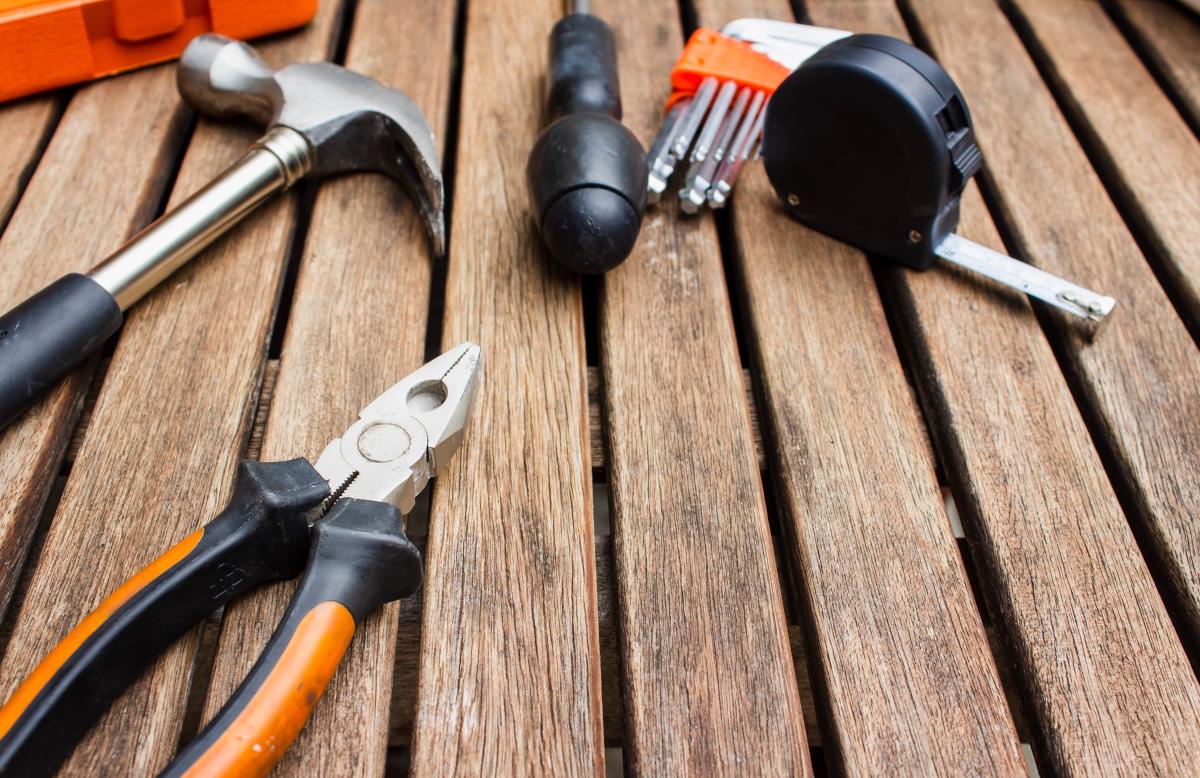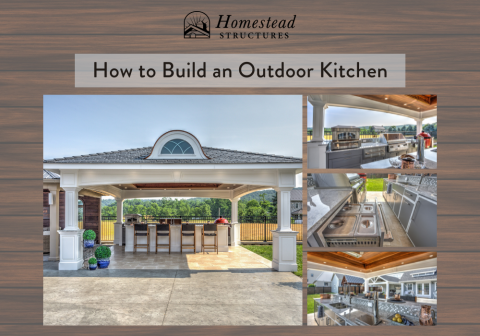Investing in building an outdoor kitchen will allow you to create memories with loved ones and get even more enjoyment from your home. What’s more, an outdoor kitchen can also add value to your home, make it more attractive to future buyers, and expand your living and storage areas.
If you have a penchant for good company, great food, and big ideas, an outdoor kitchen could be your next big project.
Choose an Outdoor Kitchen Design
The outdoor kitchen design should represent your personality but remain practical for you to fully enjoy the space.
Here are a few kitchen design ideas to get you started.

-
Themed outdoor kitchens: Whether you include a rustic Tuscan villa or a sleek Japanese teppanyaki grill, themed outdoor kitchens can transport you and your guests to different places and times.
-
Outdoor kitchen islands: This design element is ideal for those who love to entertain as it allows you to include more seating, as well as ample counter and storage space.
-
Covered outdoor kitchen space: Covered spaces protect you from the elements, allowing you to cook and dine al fresco, rain or shine.
When it comes to making the final design selection for your outdoor kitchen, several factors can influence your decision.
-
Budget and cost: Determine your budget, considering both initial costs and long-term value.
-
Materials: Consider how materials fare in your local climate.
-
Personal choice and style: Reflect your personality and culinary interests in the design, from the color scheme to specific appliances.
-
Accessibility and efficiency: Optimize the layout for seamless movement. Consider the work triangle between your grill, sink, and refrigerator for maximum efficiency.
-
Additional features: Think about adding special features like a wine cooler, smoker, or built-in speakers to tailor the space to your lifestyle.
Remember, this outdoor kitchen should mirror your personality, celebrate your roots, and cater to your culinary curiosity. These considerations can help ensure that your investment not only enhances your home but also enriches your lifestyle.
Pick a Location for Your Outdoor Kitchen
An outdoor kitchen needs to be placed strategically. There are a few guidelines you can use to determine where your outdoor kitchen should be located.
-
Look at how the indoor and outdoor spaces flow together. You want your outdoor kitchen to be an extension of your indoor living space, not an isolated entity.
-
Avoid placing your outdoor kitchen in a spot with direct afternoon sun. Similarly, consider the usual wind direction to avoid smoke from the grill blowing into your home or dining area.
-
Your outdoor kitchen should be far enough from flammable structures and materials. Also, if you have children, consider their play areas and traffic patterns to prevent accidents.
A few good places to build an outdoor kitchen include:
-
Pool houses: The strong walls, expansive windows, and rooftop terraces of pool house kitchens make for beautiful, functional spaces.
-
Pavilions: A pavilion creates a cozy atmosphere around your kitchen while providing ample shade and protection from the elements.
-
Pergolas: For privacy or an intimate setting, pergolas are the perfect choice.
-
Gazebos: A gazebo offers the perfect design for a U-shaped kitchen you can collaborate with guests in easily.
The location of your outdoor kitchen is not just a logistical decision, it’s a personal one. You want to ensure that the kitchen feels like a natural part of your overall home.
Get Measurements
Start your outdoor kitchen construction by measuring the area's length, width, and height using a tape measure, accounting for any nooks or corners. Next, measure your chosen appliances, considering ventilation and clearance. Assess counter height and depth for cooking comfort and appliance fit. Finally, ensure walkways are at least 36 inches wide for safe movement. Use these measurements to guide material purchases.
Obtain the Materials Needed for Your Outdoor Kitchen
 Every tool and every material plays a critical role in the outcome of your kitchen.
Every tool and every material plays a critical role in the outcome of your kitchen.
You’ll need these tools to successfully construct your outdoor kitchen:
-
Pliers
-
Levels
-
Hammers
-
Tape measure
-
Screwdriver
-
Drill
As for materials, opt for durable ones, such as:
-
Wood or metal frame: Hardwoods like teak or cedar are more weather-resistant and can give your kitchen a rustic look.
-
Concrete or brick: Concrete is versatile and can be shaped and colored to fit your design scheme. Bricks offer a classic look and are highly durable.
-
Stone or tile: Granite and soapstone are incredibly durable and can add a high-end, natural look. Ceramic or porcelain tiles offer various colors and patterns, allowing for more customization.
These materials are perfect for creating functional, attractive countertops and bases.
Research Required Permits
The need for a permit depends on various factors, such as the size of your project, its location, and the specific regulations of your municipality. To obtain a permit, you must generally provide detailed plans of your project, the layout, materials, and any utility connections. The approval process can take time and you may be required to pay a fee.
Some homeowners' associations may also have their own set of rules and permit requirements. Generally, if you're planning to build a permanent structure or significantly alter the landscape, there's a good chance you'll need a permit.
Failing to get the necessary permits could result in fines, or you could even be forced to dismantle your newly built kitchen. Be sure to apply well in advance to avoid issues.
Create a Construction Calendar
A construction calendar is more than just dates and deadlines. It helps you track progress, stay organized, and reduce stress during the construction process.
As you craft your construction calendar, consider including the following elements:
-
Project start date
-
Individual task deadlines
-
Permit application and approval dates
-
Material delivery dates
-
Inspection dates
-
Estimated project completion date
This way, you can stay on track and ensure everything is in order.
Prep the Different Zones
Your outdoor kitchen isn't just one big cooking space. There are several distinct zones, each with its unique function and purpose:
-
Grilling area: Ensure there is adequate ventilation, especially if it's covered or semi-enclosed. Leave enough clearance around the grill for safe and efficient cooking, and install task lighting for nighttime use.
-
Eating area: Plan the eating area based on the number of guests you usually host, taking into account the seating and table space required. Consider weather protection like retractable awnings or a permanent roof.
-
Sitting area: Choose comfortable, aesthetic, and functional seating that complements your overall space. Opt for practical ground surfaces like weather-resistant rugs or stones, and make sure the sitting area flows visually with the grilling and eating areas.
Depending on the appliances in your kitchen, you may need to run utility lines into your backyard. Overall, you want each area to be comfortable, accessible, and functional.
Start Building Your Outdoor Kitchen
Building your kitchen will depend on the style of your kitchen and the specifics of your design. However, there are a few universal steps you’ll need to follow:
-
Plan your space.
-
Gather your materials and tools.
-
Build the foundation and frame.
-
Install appliances and fixtures.
It’s best to consult a professional early on to understand the feasibility of your ideas, especially concerning utility lines and local building codes. If you're considering doing part of it yourself, talk to a builder to understand which tasks are best left to professionals.

Facebook Comments Box